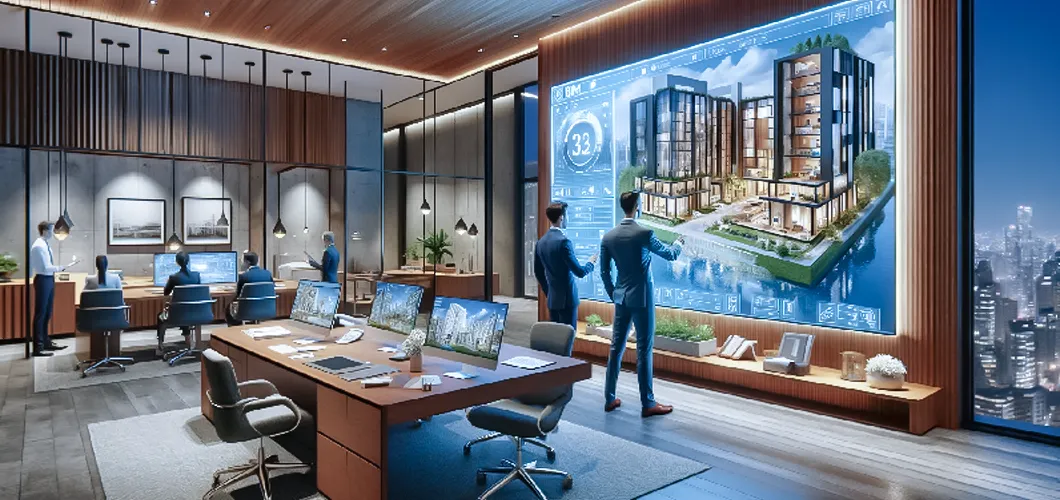
How BIM is Transforming the Real Estate Industry?
The real estate industry was the cornerstone of developed economies. In US alone, the sector made a mammoth 20.7% of the U.S. gross domestic product (GDP). Likewise, the sector has consistently accounted for 13% of the UK’s GDP for the past few years. Over the last two decades, the sector has undergone tremendous transformation, and one of the most profound changes in the sector is introduction and adoption of Building Information Modelling (BIM). Thanks to the use of BIM in real estate, a revolution has been witnessed in how buildings are designed, constructed, and managed.
In this article, our experts are going to explain how digital practices are transforming the real estate industry for good. Likewise, we’ll have a quick peep into BIM’s benefits, applications, and future potential.
Understanding BIM
BIM is a digital representation of a facility’s physical and functional characteristics, serving as a much-needed shared knowledge resource. From conception to completion and then to maintenance, BIM empowers all stakeholders with informed decision-making and makes project delivery in the construction industry cost-effective. BIM also encompasses 3D modeling software that enables architects, engineers, and construction professionals to plan, design, and manage building projects more effectively.
BIM in Real Estate
Now, let’s explore BIM’s transformation of the real estate sector.
Enhanced Design and Visualization
Thanks to BIM, the real sector has greatly benefitted from improved design and visualization. One key problem with the traditional 2D drawings was that stakeholders found it immensely difficult to interpret them. As a result, there were many miscommunications, causing costly errors and delays. BIM has solved this misery through the introduction of detailed and accurate 3D models. The interactive visual representation of the project makes it easier for everyone involved to understand the design intent.
Additionally, improved visualization means stakeholders can identify issues in the design phase, even before the construction kicks off. It prevents the need for costly revisions later in the construction phase.
Improved Collaboration and Communication
Another area where BIM has become nothing short of a revolution is collaboration and communication. BIM empowers all stakeholders with far better collaboration. BIM can seamlessly integrate models from different disciplines, such as architecture and engineering. This integrated nature of BIM permits real-time sharing and updating information.
Improved collaboration and communication mean misunderstandings will be reduced significantly throughout the project lifecycle. It leads to less errors and enhanced project coordination. As a result, projects are more likely to stay on schedule and within budget.
Increased Efficiency and Productivity
Let us remind you again: the whole concept behind BIM was to make construction projects more efficient both in terms of cost and time. Traditional methods led to delays and increased costs because of manual processes and fragmented workflows. BIM harnesses the power of digitization to automate several aspects of design and construction processes.
BIM experts also use various tools to simulate construction sequences, which is useful in planning and optimizing the construction process.
Enhanced Accuracy and Reduced Risk
Who would know it better than those associated with AEC (architecture, engineering, and construction) industry how costly even a small error can become? Thanks to the availability of detailed and comprehensive 3D models, the risk of errors in design and construction has been reduced greatly. One such study highlighted that the use of BIM can reduce design errors by up to 50% in the construction of precast concrete structures.
One of the BIM’s most powerful features is clash detection. It enables you to identify conflicts between different building systems (e.g., plumbing, electrical, and structural) before construction begins. Thanks to BIM, you can resolve these conflicts in the virtual model instead of stumbling on it in construction phase. This BIM-powered enhanced accuracy allows real estate sector to make high-quality buildings.
Better Cost Management

Cost overruns have haunted the real estate sector for a long time. However, BIM has immensely resolved this issue by providing more accurate cost estimates. Now, stakeholders can do far better cost management throughout the project lifecycle. With access to the latest tools and cutting-edge software, UK BIM experts can help stakeholders perform detailed cost analysis and scenario planning. How? Well, these tools allow you to visualize the entire project and its components, helping you identify cost-saving opportunities.
Improved Sustainability
Did you know that the construction industry alone accounts for 25-40% of global carbon emissions? Surprised? You should be!
Again, BIM has made a significant contribution to make this industry sustainable. Thanks to BIM, reworks have reduced drastically, and this reduction means less construction activities and less carbon emissions. Likewise, BIM supports sustainable building practices by facilitating the analysis and optimization of a building’s environmental performance.
Moreover, BIM empowers stakeholders to analyze various building materials and systems and pick the most environmentally friendly option. Thus, digitization is contributing greatly in making this sector adopt sustainable practices.
Learn: How does bim help with sustainability?
Enhanced Facility Management
As stated above, BIM allows modelers to create detailed 3D models during the design and construction phases. It allows facility managers to have instant and easy access to building systems. Thus, it makes maintenance activities very easy and energy efficient. By reducing downtime and extending the lifespan of built assets, BIM encourages sustainability practices. Moreover, BIM can assist in space management and planning, improving the overall efficiency of building operations.
Also check: BIM for facility management
DDC Solutions – BIM That Reduces Waste, Improves Risk Management & Makes Project Delivery Cost-Efficient

DDC Solutions has made BIM more powerful. Our experts, led by one of BIM pioneers Jimi Clarke, have re-shifted the focus on making project delivery time and cost-efficient through BIM. Our BIM solutions have helped businesses of all sizes to make their practices compliant. Book your free consultation today to get a bespoke BIM strategy for your project.
